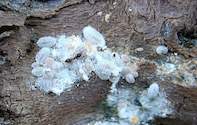Powdery Mildew or Oidium
Powdery mildew also called oidium, is caused by the fungus Uncinula necator and is considered to be the most serious grapevine fungal disease. Symptoms of oidium can be observed on the leaves, shoots and grape bunches. The first symptoms are usually faint green spots (not oil spots) on the leaves.

When the leaf is held against the light, gray-white hairs will be visible on the spots. In young vine shoots, gray-white spots appear which turns black later on. The bunches show a gray-white fungus growth on the grape skins and stalks. Oidium causes an off-flavour in wine. Oidium spores remain dormant within the bud and are immediately released when there is bud break.
The vine is susceptible to contamination and the disease should therefore be controlled early in the season. The vines should be sprayed for oidium and grapevine mealybug (which can spread the disease) at 2, 4 and 6 weeks after bud break. However, it is of utmost importance to start on time (at 2-5 cm shoot length) and not to stretch the intervals between sprays.
Like downy mildew, oidium is controlled with contact or systemic fungicides, but the disease is resistant when only one type of fungicide is used. Cultivars such as Chardonnay, Chenin Blanc, Riesling, Sémillon, Pinotage, Sultana and Muscadel, which are vigorous growers, are more susceptible than other cultivars.
There are also several vineyard practices that can limit fungal growth: Apply good canopy management and control weeds in the vineyard. Reduce nitrogen fertilization in a vigorous growing vineyard. Irrigate when the vineyard is already moist, for example in the morning. Trellising, row direction and vineyard location can contribute to the quick drying of the leaves.
Downy Mildew
Downy mildew is caused by the fungus Plasmopara viticola and is recognized by yellow ‘oil spots’ on the leaves. During humid conditions, white, fluffy fungi develop at the bottom of the leaves. Spores develop at the bottom of the oily spots and are spread by rain and wind.
Spores germinate and penetrate the leaf through the stoma at the bottom of the leaf. Oil spots appear 5 to 15 days after infection. Young bunches become brown and oily and eventually dry out and fall off. In humid conditions, white, downy fungus growth can be seen on the grape bunches. Infected berries stop growing, turn brown, shrivel and fall off. Young green shoots can also be infected.
The fungus lie dormant in contaminated plant residues on the ground. The critical period to control downy mildew is early in the season. Monitor vines for the appearance of oil spots three to four weeks after bud break. Prevent contamination with a preventive spraying program by means of contact fungicides. Spray before infection and then twice weekly during wet weather.
Note that a good coverage is required and that it will not protect new growth automatically. Rain lowers the residue levels on leaves. After infection: spray directly after infection with systemic fungicides before oil spots appear. If oil spots appear, spray with systemic fungicides directly after a warm wet night.
By Vinpro